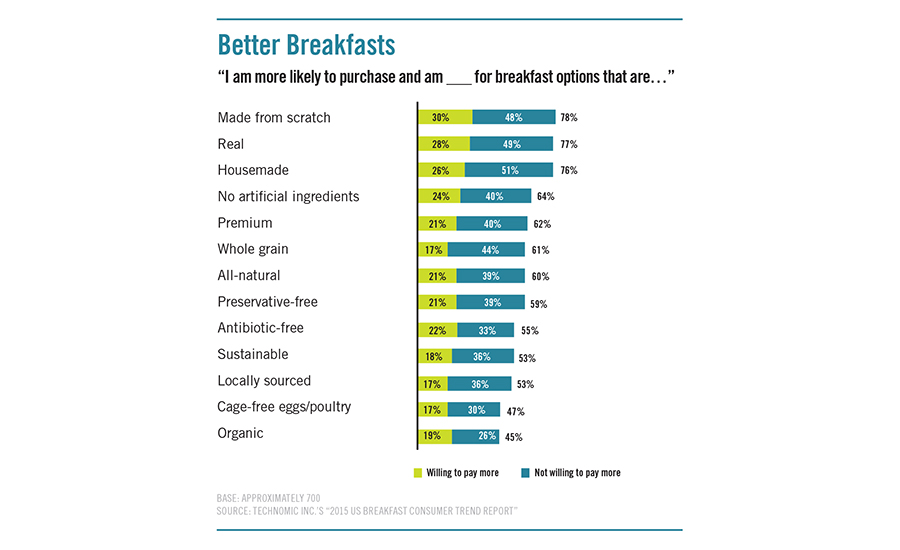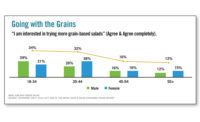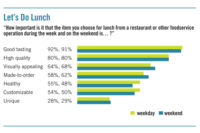Burgeoning Breakfast Menu Trends
Addressing demands for responsible sourcing, quality and variety can help boost traffic and sales at breakfast

78% of consumers are more likely to purchase breakfast options that are made from scratch, with 30% also willing to pay more.
The development of breakfast menus has become a major focus in the foodservice industry. Technomic’s “2015 US Breakfast Consumer Trend Report” provides insights into the desires and needs of consumers at breakfast and how restaurants are responding. Addressing demands for responsible sourcing, quality and variety at breakfast can help boost traffic and sales at breakfast—and throughout the day.
Quality is crucial for weekday morning meals, and consumers increasingly equate quality with better-for-you fare. In general, the majority of consumers say they would be more likely to order scratch-made breakfast items (78%), “real” breakfast items (77%), all-natural breakfast items (60%) and breakfast items free of artificial ingredients (64%).
Menu callouts of scratch-made breakfast entrées have increased 40% on limited-service restaurant menus during the past two years. More of these restaurants are replacing margarine with real butter, as mentions of butter have increased 3% overall on LSR breakfast menus since 2013.
As concerns about sourcing grow, an increasing number of restaurants are touting their use of cage-free eggs, gestation crate-free pork and grass-fed beef; 47% of consumers say they would be more likely to order cage-free eggs or poultry items.
Breakfast menu mentions of cage-free eggs have grown 40% since 2013, and that number is expected to rise. Taco John’s, Dunkin’ Donuts, Denny’s and Panera Bread are just some of the brands that have recently announced plans to increase their percentage of cage-free eggs or serve them exclusively.
Beyond freshness and sourcing, consumers look for more variety on the menu. One particular area of interest is in non-meat proteins that offer the health functions of protein—but with fewer calories and fat. Technomic anticipates more vegetarian ingredients, such as soy, tofu, beans, lentils and grains, to grow on breakfast menus, particularly at LSRs. Look for more polenta, grits, oats and seitan in breakfast dishes. Also be on the lookout for increased use of seeds (like chia) and grains, such as quinoa, in yogurts, cottage cheeses, smoothies and breakfast puddings.
Smoothies and other filling breakfast beverages will be in demand along with non-meat proteins. More than two-fifths of 18–34-year-olds say it’s important for restaurants to offer these options.
Coffee drinks and teas are other beverages of interest to consumers. Cold-brew coffee and pour-over coffee will grow at chains, as more young consumers demand specialty coffee drinks. Tea will enjoy an elevated status on menus during breakfast hours, particularly specialty tea lattes and brown-rice tea.
Ethnic-flavored items also continue to trend on breakfast menus. In 2011, 24% of consumers said they would like to see more ethnic flavors and dishes on breakfast menus; that percentage grew to 26% in 2013 and increased to 34% in the most recent report.
The growing interest in ethnic-inspired breakfast options aligns with increased diversity and adventurous eating, especially among younger consumers. These items are trending at full-service restaurants and have found their way to LSR menus; Starbucks recently launched the Spicy Chorizo, Monterey Jack & Egg Breakfast Sandwich with chorizo sausage, Jack cheese, egg, and caramelized onions on potato bread.
Breakfast items that are responsibly sourced and convey quality will be most attractive to consumers. Providing variety through non-meat proteins, ethnic flavors and filling beverages can also spur interest at breakfast, for snacks and during other dayparts.
Originally appeared in the April, 2016 issue of Prepared Foods as Burgeoning Breakfast Club.
Looking for a reprint of this article?
From high-res PDFs to custom plaques, order your copy today!






![Meal Sides Poll How often do you order a side when you visit the following [food establishment]](https://www.preparedfoods.com/ext/resources/ISSUES/November-2015/menu.jpg?height=200&t=1447435458&width=200)